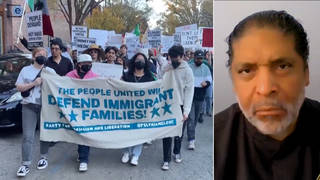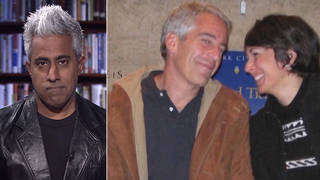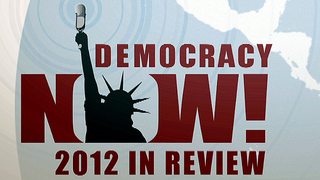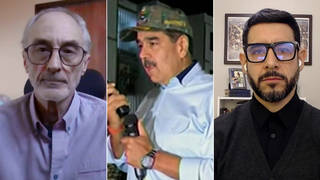
Guests
- Van Jonesserved as the green jobs adviser in the Obama White House in 2009. He is an award-winning pioneer in human rights and the clean energy economy. He is the bestselling author of The Green Collar Economy. His new book is called Rebuild the Dream.
We speak with former White House adviser Van Jones about what role the Occupy movement can and should play in re-electing President Obama. He says one reason he launched his Rebuild the Dream campaign last summer was to recognize economic issues not being effectively addressed by progressives. “We’re very good on issues around the environment, race, gender, immigration, sexuality. … But there is a hole in the donut on the economy. And the Tea Party was just driving through that hole in the donut every day.” Responding to concerns that he and others may “co-opt” the Occupy agenda, he says the movement speaks for itself, and argues his campaign can allow “the entire 99 percent” to join the conversation that Occupy began. [includes rush transcript]
Transcript
AMY GOODMAN: Our guest is Van Jones for the hour. Rebuild the Dream is his book, the first former White House administration to write about his experience inside. But it is beyond that. It’s talking about the movements he was a part of coming into the White House and where he is going now. Occupy, the Occupy movement, the significance of this, where you were on September 17th, Occupy Wall Street. People take over Zuccotti Park. Your thoughts about what you saw there and what it meant around the country?
VAN JONES: Well, first of all, I don’t speak for Occupy. I speak up for Occupy, as people need to do. But I think I was like most people. When they first went down there, I said, you know, well, they’ll probably be there for 20 minutes, and then they’ll be arrested, and we’ll have to go on and find other things to do. I wasn’t a part of it. I wasn’t part of planning it. I was aware of it, but I think, like most people, radically underestimated what they were going to be able to achieve.
However, they proved something, which I talk about in the book, which is that when you have—we always focus, often—liberals, lefties, progressives—on good ideas and the inside game. “What’s happening in Congress today? What does the president saying about this? What’s in the Ryan budget? Blah blah blah blah blah.” It turns out that when people come from the heart—talking about the head space and the heart space—the heart space and connect with the outside game, that’s when you have real game-changing moments. You know, the president is really, most of the time, just a guy on a tightrope, or hopefully someday a woman on a tightrope, just—you know, they can only lean so far to the left or the right before the laws of gravity punish them. What the Tea Party did, they came, and they moved the tightrope. While we were trying to tug on his sleeve and try to pull him to the left a little bit, they picked up the whole tightrope and moved it. Occupy moved it back. We were headed toward this awful austerity mania. The Tea Party had hijacked Congress in August of 2011, and even the President was talking about a grand bargain that was going to really put a lot of pain onto the American people’s shoulders. And Occupy just obliterated that whole discussion. The supercommittee basically disappeared suddenly and couldn’t even function, because Occupy brought up the issue of inequality, of the economy working for only the 1 percent, not the 100 percent, the 99 percent being left out. And that, I think, was a telling moment.
One of the reasons why we created Rebuild the Dream the summer before Occupy was a recognition that the economic issues in America were not being effectively addressed by the progressives. We’re very good on issues around the environment, race, gender, immigration, sexuality. All those issues are very, very important key issues, but there is a hole in the donut on the economy. And the Tea Party was just driving through that hole in the donut every day. We thought it was important to raise an economic populist view from the left that would be willing to take on the financial elites, the economic elites, but do it from a progressive point of view and not from a “destroy the government” point of view. And we were beginning to ramp that up. We had about a hundred grasstops organizations, from MoveOn.org to the SEIU and others, Planned Parenthood, and then the grassroots just took off. And so, we were able to swing right behind, push as hard as we could.
Today, what are we doing? Rebuild the Dream now has 600,000 members. We’re in every congressional district. Anybody who wants to be a part can go to RebuildTheDream.com and sign up. We are taking on what we think are the two big fights that Occupy teed up. We may not be able to save the American Dream from the point of view of, you know, everybody is going to have a McMansion and be rich, but we should be able to make a—have a country where you can work hard and get somewhere. The two big barriers right now are these. It used to be the case that the pathway from poverty into the middle class was go to college and buy a house. Today, those are the trapdoors from the middle class into poverty, because student debt is crushing a whole generation of young people who are trying to make a better life for themselves, and underwater mortgages—one-quarter of every mortgage in America underwater—is dragging people from the middle class into poverty. So the American Dream, so-called, has been turned upside down, inside out.
Rebuild the Dream has two campaigns up to get Fannie and Freddie, on the one hand, to cut the principal on these underwater mortgages so that people can actually get back to their lives and quit being trapped by the false evaluation of the banks earlier, but number two, the student loan debt is now $1 trillion. There’s more student debt in our economy than all the credit card debt combined. Every credit card in every pocket of America, you stack that up, the pile of debt is smaller than the student debt in America. That’s never happened. So we’re fighting to change that. July 1st, it could get worse if Congress lets the interest rate double on the Stafford student loans. We’re going to stop them from doing that.
But listen, I came out of the White House. I was hurt. I was sad. I felt like I had let people down. I felt embarrassed. I was confused. I took some time off. I got a chance to teach a little bit at Princeton. What I’ve decided is, I’ve got to get back, and all of us have to get back, to where we were before Obama ran. Before Obama ran, we had big movements up against the war. We mainstreamed opposition to the war, to climate concerns. We pulled the country, before Obama even ran, in a very positive direction. We got excited. We elected a president. We broke Karl Rove’s stranglehold on Congress. And then we sat down. And some of us went to work for the government. Some of us decided to try to appease the government. Some of us didn’t know what to do. But those days have got to come to an end. This war on women has to stop. The continued attacks on the safety net have to stop. And this book is my battle plan to get back—to get our movement back on track.
AMY GOODMAN: You talk in Rebuild the Dream about Occupy candidates for Congress that Rebuild is—
VAN JONES: Sure, mm-hmm.
AMY GOODMAN: —supporting. Like who?
VAN JONES: Sure, well, Rebuild the Dream is in a coalition with a number of organizations who are all putting forward candidates. I would—you know, Progressive Majority is really leading that effort. It may not be as clear as it should be in the book. Progressive Majority is leading that effort. You have Bob Borosage. He’s with Campaign for America’s Future, who’s a part of that. And we’ve identified and we’re pushing forward a number of candidates, as we say, from dogcatcher to Congress. Obviously, you know, the one we’re most excited about is Elizabeth Warren, who we think is going to be an amazing addition to the Senate, if we can get through with that.
AMY GOODMAN: A number of questions are coming in on Facebook, are being tweeted in, emailed. This is from James Hetrick, who says, “Do you think the purpose of Occupy Wall Street should be to get Obama re-elected?”
VAN JONES: No, no, no. Well, here—well, first of all—
AMY GOODMAN: And there’s a number of questions about co-opting the movement.
VAN JONES: Sure, sure, sure. Well, here’s the deal. Occupy Wall Street—again, I don’t speak for Occupy Wall Street. I speak up for them when they come under attack. Occupy Wall Street is kind of like the Student Nonviolent Coordinating Committee, right? The most idealistic, the most aggressive young people of the '60s. What did they do? They occupied the lunch counters. They occupied the buses. They occupied the voting booth in Mississippi, where that was. But they were the spearhead. But you had a whole bigger movement called the civil rights movement right behind them, that included the NAACP, who had much, you know, different set of tactics, that included Dr. King, that included CORE. I think that the movement of the 99 percent is like the civil rights movement. That's a much bigger movement. It’s going to have lots of different kind of people in it. Some will be for elections, some will be against elections. Some will be for lawsuits. Some will be for—but Occupy speaks for itself.
And it seems to me that Occupy should keep doing what Occupy is doing, which is driving the discussion. They’re experimenting in participatory democracy and showing what democracy can really look like and feel like. I think that’s an important contribution. And they should continue to do what they do. But the rest of us, 100 million people, one-third of Americans agree with them, but 100 million people are not going to go to the general assemblies, and we’re not going to go and march. Well, what should the rest of us do? The book is really talking about the rest of us. Are you going to let these young folks and struggling folks, who have gotten the conversation started, go out there by themselves, or can we come with a whole set of tactics and strategies that let the entire 99 percent movement, the 100 million people that the polls say agree with Occupy’s critique, how can we move forward? And no one group—Occupy, Rebuild the Dream or anybody else—can claim to own the 99 percent movement.












Media Options